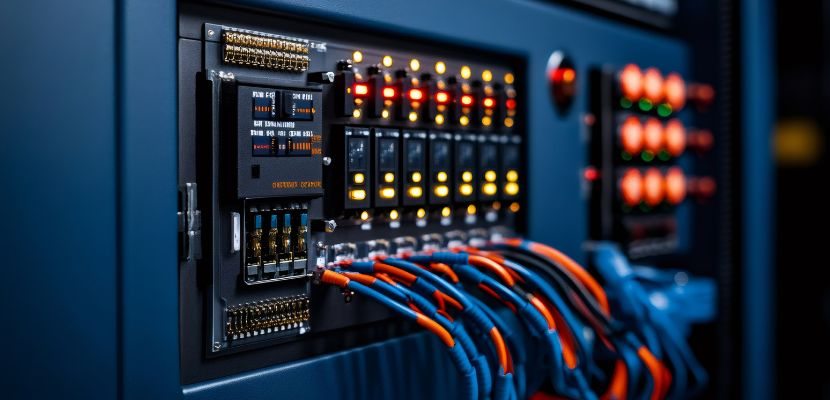Transmission Control Protocol (TCP) is a foundational communication protocol used in computer networks to ensure reliable, ordered, and error-free transmission of data between devices.

What Is the Transmission Control Protocol?
TCP is a core communication protocol within the Internet Protocol Suite, functioning primarily at the transport layer of the OSI model. It enables reliable, ordered, and error-free data transmission between devices over a network, ensuring that data sent from one host reaches another accurately and in the correct sequence.
TCP achieves this by establishing a connection between the sender and receiver before data is transmitted, using a process known as a three-way handshake. Once the connection is established, TCP segments the data into packets, each of which is tracked with a sequence number to ensure that all parts are received and reassembled correctly.
TCP Layers
TCP operates at the transport layer of the OSI (Open Systems Interconnection) model. These layers work together to facilitate reliable data transmission across networks. Here's a breakdown of each layer's role in relation to TCP.
1. Application Layer (Layer 7)
While TCP itself does not operate directly at this layer, it serves the applications running at this layer. The application layer consists of the protocols and programs that require data communication (e.g., HTTP, FTP, email protocols like SMTP, etc.). When an application wants to send data, it hands it off to the transport layer (where TCP operates) to be transmitted across the network.
2. Transport Layer (Layer 4)
This is where TCP operates, providing the primary function of reliable data transfer between devices on the network. In this layer, data is segmented into smaller units, called segments. TCP adds a header to each segment, which includes information such as:
- Source and destination ports. Identify the sending and receiving application on the respective devices.
- Sequence number. Tracks the order of segments, ensuring that the data can be reassembled correctly.
- Acknowledgment number. Used to confirm the receipt of data.
- Flags and control bits. Indicate the status of the connection, such as whether it’s establishing, closing, or maintaining communication.
- Checksum. Provides error detection to ensure the data has not been corrupted.
- Window size. Controls the flow of data, ensuring the sender does not overwhelm the receiver.
The transport layer ensures that data is transmitted reliably and in order, with mechanisms such as retransmission, flow control, and congestion control. TCP handles the process of dividing data into segments, managing acknowledgments, handling retransmissions for lost packets, and ensuring in-order delivery.
3. Network Layer (Layer 3)
The network layer is responsible for addressing, routing, and forwarding data packets from the source to the destination across multiple networks. IP (Internet Protocol) operates at this layer, encapsulating the TCP segment within a packet. The network layer does not ensure reliability or order; its primary role is to route the packet to the correct destination, using IP addresses.
Once the packet reaches the destination, it is handed over to the transport layer, where TCP ensures the data is received correctly and fully.
4. Data Link Layer (Layer 2)
At the data link layer, the network packet is encapsulated into a frame for transmission over the physical medium. This layer handles the error detection and correction of data transmission between adjacent network nodes, such as devices on the same local area network (LAN). It adds the physical address (MAC address) of the devices to the frame for correct addressing at the link level.
The data link layer doesn’t directly handle the reliability and flow control mechanisms of TCP but ensures the data is properly framed for transmission across the local network and that it is directed to the correct physical device.
5. Physical Layer (Layer 1)
This layer is responsible for the actual transmission of raw bits over the physical medium, such as electrical signals or optical pulses. It is not directly involved in TCP but is essential for enabling the transmission of the data link frames across cables, wireless connections, or other physical mediums.
How Does TCP Work?

TCP operates through a series of steps that ensure reliable, ordered, and error-free communication between devices. Here’s how it works:
- Connection establishment (three-way handshake). The first step in TCP communication is establishing a connection between the sender and receiver. This is done using a process called the three-way handshake, which ensures that both devices are ready for communication.
- Data segmentation. Once the connection is established, the sender prepares the data for transmission. The data is divided into smaller chunks called segments. Each segment is given a sequence number to help both the sender and receiver keep track of the data and ensure it can be reassembled in the correct order.
- Data transmission. The sender begins transmitting the segments of data to the receiver. Each segment includes the TCP header, which contains control information such as the sequence number, acknowledgment number, and checksum. The receiver sends back an acknowledgment (ACK) for each segment received, confirming successful reception.
- Flow control. TCP uses a sliding window mechanism to control the flow of data. The receiver communicates how much data it can accept by advertising a window size. This prevents the sender from overwhelming the receiver with too much data at once. The sender adjusts its data transmission rate based on the receiver's available buffer space.
- Error detection and retransmission. TCP includes a checksum in each segment to detect errors in transmission. If a segment is lost or corrupted, the receiver does not send an acknowledgment, prompting the sender to retransmit the segment. The sender continues retransmitting any missing or damaged segments until they are successfully received.
- Acknowledgment. Each segment that is successfully received is acknowledged by the receiver. This acknowledgment informs the sender that the segment has been successfully delivered and allows the sender to move on to the next segment. The acknowledgment contains the next expected sequence number, providing the sender with information on the successful receipt of data.
- Connection termination. After all data has been transmitted and acknowledged, the connection is terminated.
What Is a TCP Example?
An example of TCP in action can be seen during the process of browsing a website. Here’s how TCP works step-by-step in this scenario:
Step 1: Connection Establishment (three-way handshake)
- You open a web browser and enter a website address (e.g., www.example.com).
- Your browser sends a TCP SYN packet to the server, indicating that it wants to establish a connection.
- The server responds with a SYN-ACK packet to acknowledge the request.
- Your browser replies with an ACK packet, confirming the connection is now established.
Step 2: Data Transmission
- After the connection is established, your browser sends an HTTP request (e.g., to fetch the homepage of the website) to the server.
- The server then breaks the webpage data into smaller TCP segments and sends them back to your browser. Each segment has a sequence number to help both your browser and the server track the data's order.
- Your browser acknowledges the reception of each segment, sending back an ACK packet for each one.
Step 3: Flow Control
- As the webpage data is transmitted, TCP ensures that your browser doesn’t get overwhelmed by regulating the amount of data sent. The browser’s advertised window size indicates how much data it can handle at once.
Step 4: Error Detection and Retransmission
- If any segment of the data is lost or corrupted, your browser will not acknowledge it, prompting the server to retransmit that segment. The checksum field in each TCP segment helps detect errors and ensures the data is transmitted correctly.
Step 5: Connection Termination
- Once the webpage is fully loaded, your browser sends a FIN packet to the server, indicating that it is done receiving data.
- The server replies with an ACK packet, confirming that the connection can be closed.
- Finally, the server sends a FIN packet to your browser, and your browser sends an ACK to terminate the connection.
What Is TCP Used For?
TCP is used for reliable, ordered data transmission across networks, particularly in applications where data integrity and delivery assurance are crucial. It is widely used in various internet services, including web browsing (HTTP/HTTPS), email (SMTP, IMAP), file transfers (FTP), and remote access (SSH, Telnet).
TCP ensures that data is sent and received without errors, by managing the flow of information, ensuring in-order delivery, and handling retransmissions of lost or corrupted packets. Its reliable nature makes it essential for applications where performance and correctness are paramount, such as in financial transactions, online gaming, and cloud services.
How Secure Is TCP?
TCP by itself does not include built-in security mechanisms, making it inherently vulnerable to certain types of attacks such as man-in-the-middle (MITM), TCP spoofing, and denial-of-service (DoS) attacks. However, TCP is often used in conjunction with additional protocols to provide secure communication. For example, TLS/SSL (Transport Layer Security / Secure Sockets Layer) is commonly layered over TCP to encrypt data and ensure secure communication between devices, such as in HTTPS for web browsing.
While TCP ensures reliable, ordered data transmission, it does not protect against data interception or unauthorized access on its own. To achieve secure communication, applications typically implement encryption, authentication, and integrity checks at higher layers, leveraging protocols like TLS or using VPNs (Virtual Private Networks) to secure the TCP connection.
TCP Attacks

TCP attacks exploit vulnerabilities in the Transmission Control Protocol to disrupt communication, intercept data, or cause network failures. These attacks typically target weaknesses in the connection establishment, data transmission, or connection termination phases of the TCP lifecycle. Some common TCP attacks include:
- TCP SYN flood attack. This is a type of Denial-of-Service (DoS) attack where an attacker sends a high volume of SYN packets to a target server, often with a forged sender IP address. The server responds with SYN-ACK packets, waiting for the final ACK response to complete the handshake. However, the attacker never sends the final acknowledgment, leaving the server with half-open connections that exhaust its resources, causing a denial of service to legitimate users.
- TCP SYN-ACK spoofing (TCP spoofing). In this attack, the attacker manipulates the TCP handshake by sending a forged SYN-ACK response to a target, pretending to be a legitimate server. The attacker can then intercept, alter, or inject malicious traffic into the connection between the victim and the legitimate server. This attack relies on the attacker’s ability to guess or observe sequence numbers, allowing them to hijack the connection.
- Man-in-the-middle attack. In a MITM attack, an attacker intercepts or manipulates the communication between two parties. Since TCP itself does not provide encryption or authentication, an attacker can capture and alter the transmitted data, such as changing the content of an email or injecting malicious data into a file transfer. MITM attacks can be prevented by using encryption protocols like TLS or SSL, which secure the data in transit.
- TCP session hijacking. This attack occurs when an attacker takes over an active TCP session between two parties by predicting or stealing the session's sequence numbers. Once hijacked, the attacker can inject malicious commands or commands that appear legitimate to the receiver, leading to unauthorized actions being taken, such as transferring funds or stealing sensitive information.
- TCP RST (reset) attack. This attack involves sending a TCP RST (reset) packet to terminate an active TCP connection. By sending a forged RST packet with the correct sequence number, the attacker can force both the client and server to drop the connection. This can disrupt communication and force users to reconnect or cause system downtime.
- TCP flood. A more general form of a DoS attack, TCP flood involves overwhelming a target system with a large number of TCP packets, consuming network bandwidth and resources. Unlike the SYN flood, it sends complete packets (not just SYN requests), which can be harder to mitigate because they appear as legitimate traffic.
- Smurf attack (TCP variant). Though traditionally associated with ICMP, a Smurf attack can also exploit TCP. In this case, an attacker sends out a request to a large group of systems, and those systems respond to a target with data. The attacker amplifies the traffic, overwhelming the target with a flood of responses, leading to a denial of service.
- TCP/UDP reflection attack. This type of attack uses misconfigured servers (often DNS or NTP servers) to reflect malicious packets back at a target. The attacker spoofs the victim’s IP address and sends a small query to a vulnerable server, which sends a large response back to the victim, overwhelming their system.
How to Prevent TCP Attacks?
To protect against TCP attacks, several countermeasures can be implemented:
- SYN cookies. This technique helps protect against SYN flood attacks by ensuring that the server does not hold resources for half-open connections.
- Rate limiting. Limiting the number of incoming connections or SYN packets within a set time frame helps mitigate flooding attacks.
- Firewalls and intrusion detection systems (IDS). These can detect and block suspicious traffic patterns or packet anomalies associated with TCP attacks.
- Encryption (TLS/SSL). Secure connections using encryption prevent attackers from hijacking or manipulating data.
- TCP sequence number randomization. Randomizing sequence numbers makes it harder for attackers to predict or guess valid session IDs.
- Connection timeout policies. Setting appropriate timeouts for idle connections helps reduce the risk of resource exhaustion from DoS attacks.
The Advantages and the Disadvantages of TCP
TCP is a widely used protocol that offers significant benefits in ensuring reliable, ordered, and error-free communication over networks. However, it also comes with certain limitations and trade-offs. Below is a summary of the pros and cons of TCP.
What Is the Advantage of TCP?
The primary advantage of TCP is its ability to provide reliable, ordered data transmission between devices over a network. This reliability is achieved through mechanisms such as error detection, acknowledgments, retransmissions, and sequence numbering to ensure that data is transmitted accurately and in the correct order.
TCP also incorporates flow control to prevent data congestion and congestion control to avoid overwhelming the network. These features make TCP ideal for applications where data integrity, consistency, and error-free delivery are critical, such as web browsing, file transfers, and email. By guaranteeing that data arrives without errors and in sequence, TCP ensures a robust and dependable communication channel for users and applications.
What Is the Disadvantage of TCP?
One of the main disadvantages of TCP is its overhead and latency. Because TCP ensures reliable, ordered delivery through mechanisms like error detection, flow control, and retransmissions, it requires additional processing and communication between the sender and receiver. This can result in higher latency and resource consumption compared to connectionless protocols like UDP (User Datagram Protocol), which do not have these reliability mechanisms.
Additionally, TCP's connection establishment and teardown processes (such as the three-way handshake and four-way termination) further add to the time delay, making it less suitable for real-time applications like video streaming or online gaming, where low latency is critical. TCP's emphasis on reliability and ordering may also result in inefficient use of network resources in situations where speed and minimal protocol overhead are more important than guaranteed delivery.
TCP vs. UDP
TCP and UDP are both transport layer protocols, but they differ significantly in their approach to data transmission. TCP is connection-oriented, ensuring reliable, ordered, and error-free delivery of data through mechanisms like acknowledgments, retransmissions, and flow control. This makes TCP ideal for applications where reliability and data integrity are critical, such as web browsing and file transfers.
In contrast, UDP is connectionless, offering faster data transmission by omitting error-checking, flow control, and sequencing. While this reduces overhead and increases speed, it also means UDP does not guarantee reliable delivery or in-order data reception. UDP is suited for real-time applications like video streaming and online gaming, where speed is more important than absolute reliability.
What Is the Difference Between HTTP and TCP?
The primary difference between HTTP (Hypertext Transfer Protocol) and TCP lies in their respective roles and functions within network communication.
TCP is a transport layer protocol responsible for ensuring reliable, ordered, and error-free transmission of data between devices on a network. It handles the lower-level tasks of data segmentation, flow control, error detection, and retransmission, ensuring that packets of data are delivered accurately and in the correct sequence.
HTTP, on the other hand, is an application layer protocol used specifically for transmitting web content, such as web pages and resources, between a web browser (a client) and a server. HTTP defines the rules for how requests and responses are formatted and exchanged for web services.
While HTTP uses TCP as its underlying transport protocol to ensure reliable data delivery, HTTP focuses on the structure and management of the content being transferred, such as handling GET, POST, and other HTTP request types.